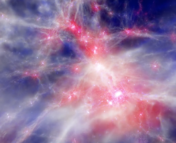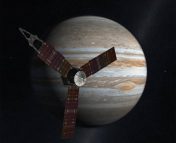Title: The Image of the M87 Black Hole Reconstructed with PRIMO
Authors: Lia Medeiros, Dimitrios Psaltis, Tod R. Lauer, and Feryal Özel
First Author’s Institution: Institute for Advanced Study, Princeton, New Jersey, USA
Status: Published in The Astrophysical Journal Letters. Press release published here.
We all remember when the Event Horizon Telescope (EHT) collaboration released the first image of a black hole, right (fun fact: we have a bite for that one!)? Well, well… With the help of machine learning, today we got a new image of the M87 black hole donut! The authors of today’s paper present a new machine learning algorithm that reconstructs the black hole image with EHT by maximizing the resolution we can currently get with the telescope data from 2017.
In order to achieve the full resolution to image the M87 black hole, we would need an Earth-sized radio telescope. However, that is not feasible yet! So instead, the EHT collaboration uses interferometry to reconstruct the image of the black hole by imaging it from several places on Earth. As you can imagine, reconstructing an image from several telescopes spread all over the world isn’t the most simple thing. In fact, numerous algorithms attempt to reconstruct M87 from the EHT data. In 2019, there were 3 main algorithms that were used for this. Each of them was tested on synthetic data with known properties, before obtaining the final M87 image (more about the 2019 algorithms on this bite).
The PRIMO Algorithm
The paper we summarize today has a new algorithm to reconstruct the M87 image called Principal Component Interferometric Modeling (PRIMO). The PRIMO algorithm paper was published earlier this year in February. PRIMO uses the principles of Principal Component Analysis (PCA) – one of the building blocks of machine learning – to reconstruct EHT images using a training set from theoretical simulations. Because EHT is an interferometer, there are an infinite number of images that could fit the data. This means that in order to obtain images out of EHT (like the M87 image), it is necessary to have imaging algorithms that make particular choices. A schematic on the algorithm is shown in Figure 1.
PRIMO differs from the other algorithms in that it does not rely on mathematical regularizations that “fill in” the missing parts of the EHT data (in math words, PRIMO can find correlations in the different regions of Fourier space to make motivated choices about unobserved Fourier components). It is quite like a physics jigsaw puzzle where some of the pieces are missing, but in this case, the puzzle has the PCA-based algorithm that is trained to find correlations between nearby regions in Fourier space and make physically motivated choices for the missing part of the data. The algorithm uses Markov Chain Monte Carlo (MCMC) to fit for the amplitudes of the PCA components as well as an overall re-scaling and rotation of all of the components.
A dozen M87 donuts, please!
The authors then apply their algorithm to the M87 data from April of 2017. The data is from 7 telescopes in 5 worldwide locations (truly a telescopic world tour!): Chile, Hawaii, Arizona, Spain and Mexico. This data has been calibrated since its original image reconstruction in 2019. The image comparison of PRIMO with the original image is shown in Figure 2.
The differences in both images are clearly on their sharpness and resolution: PRIMO is able to maximize EHT’s resolution to obtain a sharper resolution than that in 2019. The authors then compare their reconstruction to the actual EHT data by matching it to their obtained “Fourier Amplitude” and “Closure Phase” from PRIMO. This is shown in Figure 3.
To check how robust the new PRIMO image is, the authors run different MCMC sets with different numbers of PCA components and different values of total flux. Upon testing different parameters, the authors find that PRIMO is quite robust and changes to these parameters do not significantly change the M87 image reconstruction. This result is shown in Figure 4.
The M87 image reconstructed with the PRIMO algorithm presents unprecedented resolution. It is also consistent with the previous measurements of the spin axis of the black hole (17 degrees away from our line of sight) and, very importantly, it does not rely on mathematical regularizations. Although this algorithm relies on a simulation training set, the simulations span a wide range of the parameter space, encompassing a large variety of image morphologies. Since the previous EHT results demonstrated robustly that the image is consistent with a ring, it is reasonable to assume that the image will be ring-like and consistent with the simulation library.
PRIMO learns a range of morphologies from physically motivated training, maximizing the capabilities of the Event Horizon Telescope. This result not only looks really cool (and gives us a new photoshoot of our favorite black hole!), but it also has important implications for measuring the mass of the central black hole, since the black hole’s mass requires a good measurement of its size!
Astrobite Edited by: Janette Suherli and Dr. Lia Medeiros (also 1st author of the paper)




